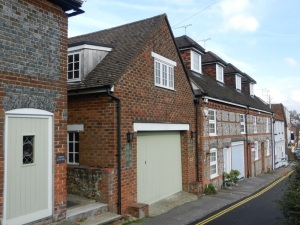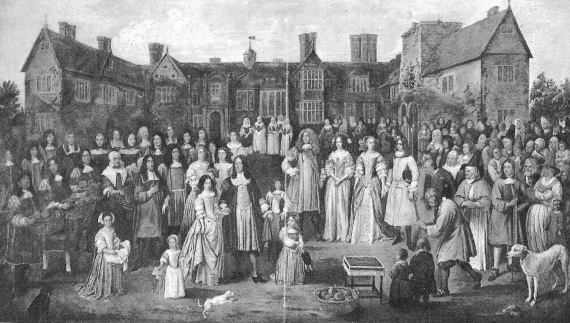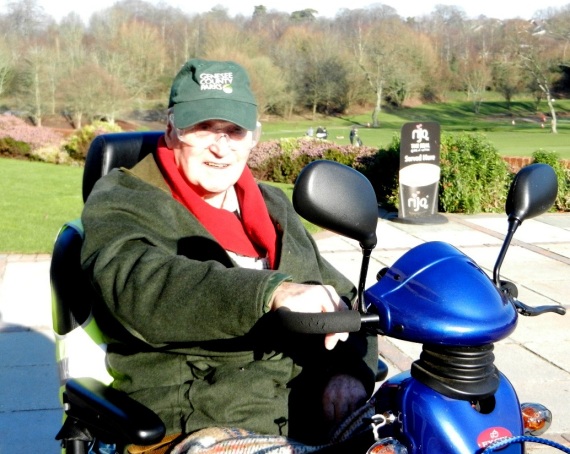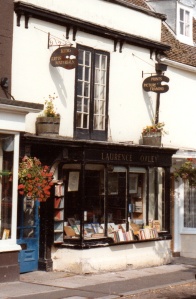Any historian looking at events in the last 50 years or so in Alresford will inevitably meet up with the name of George Watson. George’s Dad was Jock Watson (real name George too), the gardener for Sir Francis and Lady Lindley at the Weir House. In fact George was born in one of the cottages next to Weir House: many of the estate staff lived in these cottages. This was in 1933, and he spent most of his childhood living on the Weir House estate. At that time this included all the river down to the Eel House, plus the fields on either side of the river: the Fulling Mill at that time was more of a mill and less of a house, as the old 1930s pictures show. This was also part of the Weir House estate, and George’s family lived there for a while, before moving back to one of the cottages by the house. The fields mainly were used for horses and cows – one of those fields, running up to the cottages east of The Dean, was used for the big horses that were used to pull the fire engine, then kept in the Old Fire Station in Broad Street.

Fulling Mill, 1930s (c) http://www.alresfordheritage.co.uk
Sir Francis also had fishing rights down to Itchen Stoke and shooting was organised in Arlebury Park, both used for the entertainment of various high society visitors to Weir House. Sir Francis also owned the cress beds and Laundry on the little weir: the mill house buildings were later owned by Mrs Flood. [The Alresford Museum has various documents relating to the later sale of the separate parts of the estate, after the demise of Sir Francis.]
Another visitor who came to the Weir House for the trout fishing was Neville Chamberlain, around the beginning of the war, at a time when he was the Prime Minister (he died in November 1940): George found his visit particularly memorable as Chamberlain gave George a silver sixpenny coin! [That at least should be enough proof for Brian Rothwell to believe that Chamberlain did indeed visit the Weir House for fishing – see his article “Neville Chamberlain in Old Alresford?” in Alresford Articles, Issue 3, the Weir House Edition, from the Alresford Historical and Literary Society in 2013].
World War II at the Weir House

Weir House (c) http://www.alresfordheritage.co.uk
WW2 came, starting when George was aged seven. George remembers aircraft dropping incendiary bombs, 2” cylinders over a foot long, around Alresford: he found several embedded in the lawns of the Weir House, still live, and apparently with help from his Dad took them indoors: two of them were displayed proudly above the fireplace, on either side of the mantle-piece, like ornaments! The contents slowly formed a white powdery crust on the outside of the bombs, at the several joints along the body, and his Dad used to brush this white powder off into the fire, where it caused sparks and crackles! The local fire service chief was a frequent visitor to buy honey and watercress: one day he noticed the incendiaries and immediately called out the bomb disposal people to deal with them. George says they blew them up, making a six foot diameter hole in the field, mainly just from the over-zealous use of their explosives!
Lady Lindley’s brother, Simon Fraser, was the 15th Lord Lovat, living at Beaufort Castle in Inverness: mobilised as a Captain in the Lovat Scouts, at the outbreak of war he volunteered to join one of the new commando units being formed by the British Army – by 1942 he was appointed the commanding officer of No.4 Commando. Either for R&R, or more likely before missions into Europe, Commandos were often billeted at the Weir House. They didn’t actually practice with guns around the estate, but the trout in the river were rather tempting, so they made catapults and managed to kill the fish that way, using small stones for ammunition.
Real ammunition was used by the Alresford Volunteer Rifles, and they had an Armoury at the top of the Dean where Wild Brothers are now. Rifle practice was in the field North of the Bishop’s Sutton Road, with targets against the railway embankment. Inevitably some bullets went over the railway into the field beyond, and George collected some of these – with permission from the farmer, he added. The other major event in the war was the crash of the Flying Fortress called the ‘Lady Luck’ one evening, at the top of Alresford pond. Like all the other lads George went racing up there on his bike, to see the fires, and find what souvenirs they could. In a combined effort they nearly managed to get a big machine gun out of the field, but the Policemen came along and stopped them. The US bomb group people took most of the interesting bits back. George later did some metal detecting to find some shells and other bits of the plane.
School, and work for Laurence Oxley
George went to The Dean School, and then Perins: he has vivid memories of the pre-war time at the Dean School, in particular the toilets outside the back, which used an earth urinal. Every so often blocks of peat were delivered, to refresh the process, but even so in hot weather the smell was pretty bad. He thinks it might have been the caretaker’s job to take out the surplus solids and bury them behind the school in the lawn….
After leaving school George went to work on the cress beds for two years. He did his national service from 1950-52, in the Air Force, serving at Padgate and Odiham. Around this time, Sir Francis gave up part of his land on the South side of the river for use as the War Memorial gardens and Swimming Pool. On returning to Alresford, George had jobs with Doidge the builder of West Street, and worked for Colonel Allen as a gardener: but then found his next major employment with Dudley Grace, building trailers.

Pound Hill 2015: it is not known in which garage Dudley Grace started his trailer business! Both are modern conversions. Further down is O’Rourke’s Wine bar/Rio Rio, in the 70’s/80’s.
Dudley Grace started his business based in the field at the corner of Drove Lane, where he had a house. Scattered around the field were the remains of old vehicles, where Dudley had removed the axles to make trailers. These were then constructed in the garage/shed premises on Pound Hill initially, but he then took over a long low building in the Dean that was the Smithy and Forge previously run by Mr Best, in the 1920s, and later by Tom Baker. This was next to the Dean School, where the curtain factory now stands. Tom Baker lived in one of the houses opposite the Dean School, and was known for firing his anvils at the Alresford carnival in the early 1950s, famously destroying his own hat once when he got too close. George worked there for a few years, first in the forge, making the trailers, and later over the road in the newly built sheds there, that later became known as Warwick Trailers.
After this a change of career was on the cards, in around 1957. He had been repairing furniture for Oxley’s bookshop in Broad Street part time, so he left the trailer business and started full time work for Mr Oxley. He also married Beryl, who came from Ropley, and worked for Eddolls on Broad Street: they lived in the George Yard. His work at Oxleys involved making picture frames, repairing and restoring furniture, and also occasionally – once every 2-3 months – running the printing business in the basement, particularly when they needed more original prints. This work frequently involved printing from copper plates, and the most notable of this output was of the drawings and cards produced by Albert Edward Wade (see the Alresfordmemories.wordpress.com article about Wade). There were also Parish magazines, and other printing for the town’s businesses.
George also printed Moody’s history of Hampshire there, which contained 200 plates of A5 size, and was involved with creating the Wade painting that is now in St John’s Church. George provided a lot of his Wade souvenirs, including the painting showing the demolition of the water tower at the top of Jacklyn’s Lane, to Roy Robins for the town museum: this now hangs in the Alresford Library. Oxley also cleaned pictures at this time, and George was involved in this work, cleaning the picture of Charles I that used to hang in Ropley Church, an oval picture of Henry Perin, and one of the Tichborne dole (as below), prior to the loan from Tichborne House to an Exhibition in the USA. The picture shows Sir Henry Tichborne distributing the Dole in 1670, and was painted by the Flemish painter Giles Tilburg. Interestingly, most of the people shown, including the villagers, can be identified from the key that goes with the picture. Several other pictures with WWII bomb and fire damage from Portsmouth Cathedral were also cleaned at Oxley’s.

From 1957 to 1977 George also served as a part-time fireman in the Alresford Fire Service: somewhere in there he also fitted in occasional work for White & Etherington, who were based in the old ARP yard on Mill Hill – the main result of this labour seemed to be pit props, made from local trees cut into 6” or 8” square posts.
Freelance work
In 1977 George and Beryl decided to set up their own business doing the carpentry work and making picture frames. So he rented single room premises – the barn on Mill Hill, and ran the business there for 10 years. For many years after that his wind vane on the barn had an image of him working at the bench – see the photo. Being just a barn, George had to dash home occasionally to George’s Yard, to get to a cup of tea and a toilet! The barn of course has now been totally rebuilt into a smart new house.
After 10 years on Mill Hill, George felt like another change, so they set up a picture framing business in the Old Fire Station at the bottom of Broad Street. Beryl was also involved in this business, choosing and cutting the mounts for the pictures. While there, for around 13 years before retiring, George found various other old articles in the Fire Station that were donated to the Museum.
George was very keen to help with the Roy Robins project to create a town museum, and passed over a lot of items to help him establish a good collection of the town history. George had collected many interesting items in his time in Alresford, for example things found within buildings when renovation work was undertaken. When Mr (AE) Childs closed his hardware shop in East Street suddenly, to retire to a nursing home, he left a lot of old stock and other items in place. So when the house went up for sale, George rescued a few samples, including the shop ledger, and these were also donated to the Museum. There are many more stories he could probably tell…..
….just a few of George’s stories about buildings in The Dean!
Many pictures have been found of the various old buildings and businesses in The Dean, which can be seen on the website www.Alresfordheritage.co.uk. Some are shown above, and as small pictures below, all are the copyright of the Alresford Heritage website, or other copyrights, and reproduced here with permission.

The Forge, 1920s (c) http://www.alresfordheritage.co.uk

Mr Best at the Forge (c) http://www.alresfordheritage.co.uk
Behind Tom Baker’s Smithy was a shed, and Dudley Grace parked the buses he owned around this shed, accessed up a little side lane. Pictures of the Forge in operation can be seen on AlresfordHeritage.co.uk. The other bus yard, owned by Mr Vickers, was accessed via the lane near Fairlight Villas, where a printing works existed until recently: now there are two houses there. The Vickers bus service is featured in another Alresford Memories story.
There is another lane on the other side of Fairlight Villas, next to Faccombe Cottage, which leads to the cress beds that were owned by the Dorey family, who lived in the big house accessed from Ladywell Lane – this house backs on to these cress beds.
 A spinster relation, Miss Dorey, lived in the old farmhouse further up the Dean, now called the “Malt House” with the shed at the front, and also the barn – labelled and dated in the bricks “1772” – on the east side of the road. George refers to this barn as the hay barn, as he regularly used to stack hay into there. Opposite this house was the Dorey family turkey farm, extending from where Huxley’s and CLC are now, down to the Riverside Cottages. The town gas works was slightly up the hill from the turkey farm. The current house name comes from earlier, from before when John Howe lived there, around 1828. He was a clockmaker, but he also continued the malting/brewing business, using the site of the house next door, #58, now Western Court (or similar). The barn has now been modernized, but the picture shows it in the 1980s. John Howe’s previous premises, for his watch and clock-making business in 1803, was 17 Broad Street, later to become Laurence Oxley’s shop!
A spinster relation, Miss Dorey, lived in the old farmhouse further up the Dean, now called the “Malt House” with the shed at the front, and also the barn – labelled and dated in the bricks “1772” – on the east side of the road. George refers to this barn as the hay barn, as he regularly used to stack hay into there. Opposite this house was the Dorey family turkey farm, extending from where Huxley’s and CLC are now, down to the Riverside Cottages. The town gas works was slightly up the hill from the turkey farm. The current house name comes from earlier, from before when John Howe lived there, around 1828. He was a clockmaker, but he also continued the malting/brewing business, using the site of the house next door, #58, now Western Court (or similar). The barn has now been modernized, but the picture shows it in the 1980s. John Howe’s previous premises, for his watch and clock-making business in 1803, was 17 Broad Street, later to become Laurence Oxley’s shop!
Valdean, the caravan park, was originally a US Army camp in the war, with semi-circular section Nissen huts spread around the road network the Army laid down in the field there. The Valor family bought the field from the US Army, and first used the huts for the temporary housing of returning soldiers and their families. These were later replaced by the current mobile and trailer homes.
 Opposite the Valdean caravan park, the Alresford Volunteer Force Armoury was labelled with a large green painted wooden sign board, that had a red edging, but no pictures of this exist on the outside of the old flint built building there, which now faces onto the yard owned by Wild Brothers. This must be the old armoury, but if anyone has a picture to prove it, we’d all like to see a copy! The nearest modern (1959) approach to such a sign is pictured here, positioned high on the flint wall. The old (1823) Methodist Chapel on Pound Hill appears to back onto this flint walled building, which must have been the AVF Armoury.
Opposite the Valdean caravan park, the Alresford Volunteer Force Armoury was labelled with a large green painted wooden sign board, that had a red edging, but no pictures of this exist on the outside of the old flint built building there, which now faces onto the yard owned by Wild Brothers. This must be the old armoury, but if anyone has a picture to prove it, we’d all like to see a copy! The nearest modern (1959) approach to such a sign is pictured here, positioned high on the flint wall. The old (1823) Methodist Chapel on Pound Hill appears to back onto this flint walled building, which must have been the AVF Armoury.
Subsequently a further reference was found: Digby Grist in the Alresford Displayed of 1980, mentions that the 16th Hampshire Volunteer Rifle Company was formed in 1860, and had its drill hall in the premises of the British School in the Dean – which Digby said was in 1980 occupied by Wild Bros, so is presumably the same building that became the Armoury.
And in 2015…

These days George can often be seen on his big mobility scooter heading out for his morning drive, which can include a visit to the Golf Club, or a trip to Alresford shopping: he specially appreciates the help given by the local shopkeepers, who will frequently be seen delivering the required items to George, parked outside on the pavement.
Footnote:
The Alresford Museum Artefacts listed as found by George Watson, and donated to the Alresford Museum – some coming from the Old Fire Station – are as follows.
A1019a: Fireman’s bucket with leather strap, which could have been similar to the ones in the Alresford Old Fire Station. But Geo Watson bought this when in the OFS, it was made by Merryweather, who made the fire engine..
A1019b: Glass bulb fire extinguisher, known as a Harden.
A1019c: WW2 Fireman’s Axe.
A1019d: Shells from site of Lady Luck Flying Fortress crash.
A1019e: A section of a charred beam from Lawrence Oxley’s house (17 Broad Street) in Alresford’s first fire.
A1019f: Inside of incendiary bomb, picked up by GW from the lawn of the Weir House after raid in WW2.
A1027: Lead bullets from Alresford Volunteer Rifles practice range, found by metal detector near the rifle range, BS Road, 29 Sept 03 (approx?) by permission Mr Cole of Western Court.
A1006: Cap badge Alresford volunteer rifles: GW found this with the metal detector when looking for bullets on the rifle range, see 1027 above.
A1028n: Indentures on parchment: Nathaniel Bradley of Alresford 1672 and 1748 in Essex – GW said he collected it from Childs shop when it was closed down.
Other items were Bachelor’s bottles (A1020a to d), and the town batons (A1029a and b). The NATT Alresford Museum Committee are grateful for these donations, now added to the town collection of artefacts and records. George also donated various other documents and photos to the Museum, which are listed separately.
 Postscript 1:
Postscript 1:
Isabel Sanderson, in Volume 9 of her series “Dwellings in Alresford” includes just a sketch of the AVF Drill Hall in the Dean, later their Armoury, with the comment that this was the British School from 1851-1888.
Postscript 2:
The Royal British Legion Festival of Remembrance in 2019, 75 years after the end of WW2 mentioned that Lord Lovat, landing in the chaos on a Normandy beach in 1944, presumably with 4 Commando, marched his troops up the beach in a column, just like they would do on the parade ground.


Posted by Prof John Walter, University of Essex on March 1, 2016 at 1:02 pm
Fascinating. I believe, according to a report in the Hampshire magazine, 1979, George restored, or arranged for the restoration of, the painting of the Tichborne Dole, at Tichborne Park. I am working on the painting as part of a larger book on the History of the Tichborne Dole and would be very pleased to hear of any further information relating to this. Many thanks.
It sounds like the US Exhibition was ‘The English Country Treasure House’ exhibition, in Washington.
Posted by alresfordmemories on March 2, 2016 at 10:54 am
Thanks for that comment: a copy of that picture (in B&W) is now added above, taken from Edward Roberts’ and E Crockford’s ‘A History of Tichborne’ from Alresford Library. See also http://www.historic-uk.com/CultureUK/The-Tichborne-Dole .